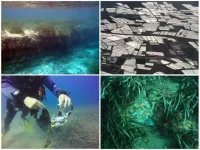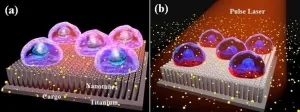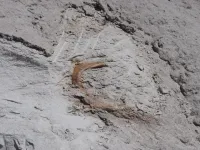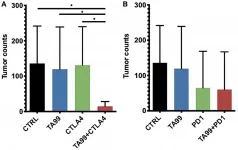(Press-News.org) The carbon footprint of plastic production for initial use is greater than the global warming impact of the entire process used for medical device reprocessing Use of reprocessed devices is environmentally superior to use of original products in 13 of 16 categories evaluatedReprocessing found to advance "circular economy," a key strategy for reaching the UN Sustainability GoalsLCA offers evidence showing that in order to reduce greenhouse gas emissions and honor the Paris Climate Agreement, EU Member States must opt-in to EU Medical Device Regulation (MDR)'s reprocessing/remanufacturing provisions
[Berlin / Washington, DC - 25 January 2021] Hospitals could cut emissions associated with some medical device use in half by opting instead for regulated, reprocessed "single-use" medical devices. The LCA evaluated the use of a reprocessed electrophysiology catheter compared with the use of original catheters for 16 different environmental impact categories and found that the use of reprocessed devices was superior in 13 categories.
The study, conducted by Fraunhofer Institute for Environmental, Safety, and Energy Technology UMSICHT, a division the world's leading applied research organization Fraunhofer-Gesellschaft and published in Sustainability, is the first comprehensive LCA exploring the environmental impact of a reprocessed "single-use" medical device compared to the "take-make-dispose" use of "single-use" original devices.
"By avoiding the use of virgin materials, reprocessing can reduce the environmental impacts of resource consumption and emissions, such as reducing abiotic resource use and the global warming impact (GWI)," said Anna Schulte, M.S.c., Fraunhofer Institute for Environmental, Safety, and Energy Technology UMSICHT and lead study author. "Hospitals that want to reduce harmful environmental impact should strongly consider using remanufactured 'single-use' medical devices like the EP catheters we studied."
"This comprehensive LCA confirms what we've thought to be true - that reprocessed medical devices are significantly environmentally superior to the original device," said Daniel J. Vukelich, President and CEO, Association of Medical Device Reprocessors. "These definitive environmental benefits, combined with the well documented financial and supply chain resiliency benefits of reprocessed devices make clear what EU Member States gain by 'opting in' to the EU MDR, and that hospitals already using remanufactured devices should double-down and expand their reprocessing programs."
Healthcare is particularly wasteful and toxic.
Last December, the Journal Health Affairs concluded that the health sector is "responsible for 4.6% of global greenhouse gas emissions" and that the "vast majority of health care global greenhouse gas emissions originate in the supply chain." Hospital's over-reliance on "disposable" or "single-use" medical devices and equipment over the last 30 years has been further exacerbated by the challenges associated with COVID. And supply chain vulnerabilities have demonstrated that reliance on a disposable culture may not always provide healthcare workers with the supplies they need.
LCA Finds Reprocessing Superior in 13 of 16 Environmental Impact Categories
The authors researched 16 "Impact Categories" and found reprocessed catheters superior to original catheters in 13, including:
Ozone Depletion. Reprocessed devices reduced ozone depletion by nearly 90% (89.7).
Climate Change. Reprocessed catheters cut CO2-equivalent emissions in half (50.4%).
Photochemical Ozone Formation. Reprocessed devices reduced human health-impacted photochemical ozone formation by 72.8%.
Respiratory Inorganics. Reprocessed devices reduced disease incidents from respiratory inorganics by 66.8%.
Cancer Human Health Effects. Reprocessed catheters reduced cancer causing human health effects by 60.9%.
Disinfectants and cleaning agents used for reprocessed catheters were found to elevate two environmental impacts for reprocessed devices compared to original catheters: land use for agriculture associated with citric acid cleaning agents (15.2%) and eutrophication freshwater use (25.1%). The authors note however, that certain environmental inputs for original catheter production are unknown and thus not entered in their calculations.
The environmental analysis confirms that reprocessing leads to a significant reduction in global warming, when studying the "cradle to grave" impact of water, sterilization gasses, detergents and disinfectants, packaging materials, electricity (excluding the electricity used in original plastic production which is unknown by the authors).
Global Warming Impact of Plastic Manufacturing for Original "Single-Use" Medical Devices
The Fraunhofer researchers found that the global warming impact of plastic manufacturing for original EP catheters, which is avoided when using their reprocessed counterparts, accounts for more CO2 than the entire process of reprocessing, including the impact of cleaning the devices.
Global Use and Impact of Reprocessed SUDs
Reprocessing "single-use" medical devices, which requires regulated, commercial companies to collect, clean, sterilize, test and return devices for use again at hospitals is already in place at over 7,600 hospitals in the United States, Canada, Germany, England, Israel and Japan, yet only a small percent of the devices that can legally be reprocessed are. In the EU and the US, over 300 devices labelled for "single-use" are CE marked and cleared by FDA respectively for reprocessing.
Sustaining value after the end of life for SUDs helps hospitals to lower costs, as reprocessed devices cost significantly less than their original counterparts. Use of the reprocessed devices helps hospitals redirect money to pressing needs, such as, toward fighting COVID-19.
INFORMATION:
About Fraunhofer-Gasellschaft
The Fraunhofer-Gesellschaft, headquartered in Germany, is the world's leading applied research organization. As a pioneer and catalyst for groundbreaking developments and scientific excellence, Fraunhofer helps shape society now and in the future. Founded in 1949, the Fraunhofer-Gesellschaft operates 74 institutes and research institutions throughout Germany. The majority of the organization's 28,000 employees are qualified scientists and engineers, who work with an annual research budget of 2.8 billion euros. Of this sum, 2.3 billion euros is generated through contract research.
About AMDR
The Association of Medical Device Reprocessors is the global trade association for the regulated, professional single-use device reprocessing and reprocessing industry. For 20 years, AMDR has promoted reprocessing as an important healthcare strategy that helps hospitals and healthcare providers increase quality, reduce costs, and strengthen the supply chain. AMDR protects the interests of its members in regulation, legislation and standard-setting.
AMDR members include Innovative Health, Medline Renewal, NEScientific, ReNu Medical, Stryker Sustainable Solution, Sustainable Technologies (a Cardinal Health Business), and Vanguard AG. Having played a key role in the establishment of the reprocessing industry, AMDR continues to push the global medical technology industry and lead the way for reprocessing to play a defining role in the evolution and use of new device technologies.
Large-scale production of vegetables and fruit in Spain with intensive plastic consumption in its greenhouse industry is believed to have leaked microplastic contaminants since the 1970s into the surrounding Mediterranean seagrass beds. This is shown in a new study where researchers have succeeded in tracing plastic pollution since the 1930s and 1940s by analyzing seagrass sediments.
About half of Sweden's cucumbers and a fifth of the tomatoes in Sweden are currently imported from Spain according to the Swedish Board of Agriculture. A special area in Spain where large-scale vegetable cultivation ...
Overview:
A research team at the Department of Mechanical Engineering at Toyohashi University of Technology developed a nanosecond pulse laser-assisted photoporation method using titanium-oxide nanotubes (TNTs) for highly efficient and low-cost intracellular delivery. The proof of concept for the possibility of intracellular delivery after irradiation with nanosecond pulse laser on TNTs was validated. TNTs were formed on titanium sheets using the electrochemical anodization technique at different voltages and times. HeLa - human cervical cancer cells were cultured in the nanotubes and submerged in a solution of biomolecules. After cells were exposed to nanosecond pulse laser, we successfully delivered ...
There isn't much in Kamchatka, a remote peninsula in northeastern Russia just across the Bering Sea from Alaska, besides an impressive population of brown bears and the most explosive volcano in the world.
Kamchatka's Shiveluch volcano has had more than 40 violent eruptions over the last 10,000 years. The last gigantic blast occurred in 1964, creating a new crater and covering an area of nearly 100 square kilometers with pyroclastic flows. But Shiveluch is actually currently erupting, as it has been for over 20 years. So why would anyone risk venturing too close?
Researchers from Washington University in St. Louis, including Michael Krawczynski, assistant professor of earth and planetary sciences in Arts & Sciences and graduate student ...
Abusive bosses may retain their positions by taking superficial steps to repair their social images following outbursts, without acting meaningfully to change their behaviors, according to research led by a University of Wyoming business management expert.
Shawn McClean, an assistant professor in UW's College of Business, joined colleagues from the University of Iowa, the University of Nebraska-Lincoln and Texas A&M University in conducting the research, which appears in the journal Personnel Psychology. Their study also was featured in Harvard Business Review, a preeminent business magazine.
"Our study shows that supervisors are often driven by simply repairing their social image rather than ...
Male breast cancer patients were found to have a high prevalence of cardiovascular conditions, in a small study of this rare patient population presented at the American College of Cardiology's Advancing the Cardiovascular Care of the Oncology Patient Virtual course.
"Due to the rarity of male breast cancer, there is no cardiovascular data from larger clinical trials or population studies. The lack of large data makes it even more important to individualize cardiovascular assessment and management based on each patient's unique oncologic, therapeutic and pre-existing cardiovascular risk profile to support them through cancer treatment into survivorship," said Michael Ibrahim, fourth year ...
PHILADELPHIA, PA - January 25, 2021 - Opertech Bio, Inc., today announced the publication of a seminal research article describing the application of its pioneering TāStation® technology to the pharmacological characterization of human taste discrimination. The findings are published in the peer-reviewed Journal of Pharmacology and Experimental Therapeutics, JPET.
The paper, entitled "Rapid throughput concentration-response analysis of human taste discrimination," is the first to quantitatively define the concentration-response function for human taste discrimination, a crucial step in understanding ...
In a study of local rivers, experts at the University of Nottingham in the UK have discovered more invertebrates - animals without a backbone, such as insects and snails - living on litter than on rocks.
In urban rivers where there are no better alternatives, litter provided the largest, most stable and complex habitat available for invertebrates to live on.
The findings could have important implications for the management of urban rivers, including how river clean-up events are conducted.
The research team, in the School of Geography, studied three local rivers; the River Leen, Black Brook, and Saffron Brook, in ...
DISCOVERY BRIEF:
The first new skull of a rare species of the dinosaur Parasaurolophus (recognized by the large hollow tube that grows on its head) discovered in 97 years.
Exquisite preservation of the new skull gives paleontologists their first opportunity to definitively identify how such a bizarre structure grew on this dinosaur.
For the first time, this study found characteristics to link tube-crested dinosaur species found in southern North America (New Mexico, Utah), distinct from the only northern species (Alberta).
The locality, in northwestern New Mexico, is dated to about 75 million years ago, a time when North America was divided by a shallow sea and teemed with duckbilled dinosaurs, horned dinosaurs and early tyrannosaurs.
Fossils from ...
The cover for issue 2 of Oncotarget features Figure 4, "Combination therapy TA99/ICB reduced the lung tumor burden in the B16 model of metastases," published in "Improved therapeutic efficacy of unmodified anti-tumor antibodies by immune checkpoint blockade and kinase targeted therapy in mouse models of melanoma" by Pérez-Lorenzo, et al. which reported that here, the authors showed that removing immune suppression and enhancing stimulatory signals increased the anti-tumor activity of unmodified TA99 antibodies with a significant reduction of ...
The cover for issue 1 of Oncotarget features Figure 2, "Results in clinical trials," published in "Drug resistant cells with very large proliferative potential grow exponentially in metastatic prostate cancer" by Blagoev, et al. which reported that most metastatic cancers develop drug resistance during treatment and continue to grow, driven by a subpopulation of cancer cells unresponsive to the therapy being administered.
There is evidence that metastases are formed by phenotypically plastic cancer cells with stem-cell-like properties.
Currently, the population structure and growth dynamics ...





